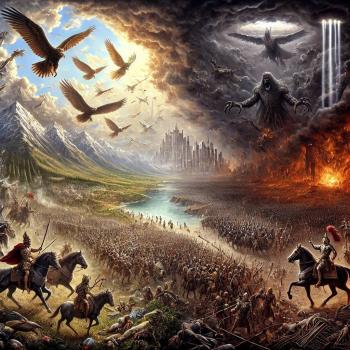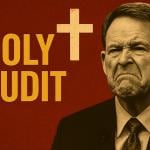The apostle Paul writes some important information about the Antichrist, whom he calls “the lawless one,” in his second epistle to the Thessalonians. He begins by correcting a false notion that had been circulating among Christians, that Jesus’ predicted return from heaven had already occurred. But in Paul’s correction of this falsehood, he mentions a “restraining” of the existence of the Antichrist that is obscure to us. Thus, there has been a lack of scholarly consensus as to what Paul means by this restraining. Many scholars claim it one of the most difficult portions to understand in Paul’s biblical corpus. In order to examine this seeming conundrum, it helps to have some knowledge about Paul’s eschatology.
Paul’s Eschatology in Acts
Paul, also named Saul, was a Pharisee being trained in Jerusalem for rabbinical ministry. While he was on a journey to Damascus to imprison some Jewish Christians, Paul had a vision in which he says Jesus of Nazareth spoke to him (Ac 9.1-22). Being dramatically converted to faith in Jesus, he began proclaiming among Jews that Jesus was “the Son of God” and “the Messiah” of Israel (vv. 20, 22). Paul’s message mostly centered on two things: (1) the bodily resurrection of Jesus from the dead and (2) that people could be forgiven of their sins by believing Jesus died for our sins (13.30-39; 1 Cor 15.3-4). But Paul received such Jewish opposition to this message that he became the apostle to the Gentiles (v. 46). For the rest of his life, he traveled in much of the Roman Empire, spreading the gospel, the “good news,” about the risen Jesus. Perhaps no one has ever had as profound an impact on Christian faith as has the apostle Paul.
When Paul became a Christian, much of his eschatology as a Pharisee did not change. He still believed in the future resurrection and judgment at the end of the age, with a utopian world to follow. His change of mind was that Jesus was Israel’s Messiah who died for our sins and that at the end of the age he would reappear to raise the dead, judge the world, and establish the worldwide kingdom of God.
For example, “Paul stood in front of the Areogapus” in Greece and preached that God “commands all people everywhere to repent, because he has fixed a day on which he will have the world judged in righteousness by a man whom he has appointed, and of this he has given assurance to all by raising him from the dead” (Ac 17.30-31). And when Paul was arrested and defended himself before Governor Felix, he proclaimed, “I worship the God of our [Jewish] ancestors, believing everything laid down according to the law or written in the prophets. I have a hope in God—a hope that they themselves [his Jewish accusers] also accept—that there will be a resurrection of both the righteous and the unrighteous” (Ac 24.14-15).
We also read in Acts, “Paul and Silas . . . came to Thessalonica, where there was a synagogue of the Jews. And Paul went in, as was his custom, and on three sabbath days argued with them from the scriptures, explaining and proving that it was necessary for the Messiah to suffer and to rise from the dead, and saying, ‘This is the Messiah, Jesus who I am proclaiming to you’” (Ac 17.1-3). So, the apostle Paul was the founder of the church at Thessalonica.
The book of Acts comes to an end by relating that Paul lived in Rome “two whole years at his own expense and welcomed all who came to him, proclaiming the kingdom of God and teaching about the Lord Jesus Christ with all boldness and without hindrance” (Ac 28.30-31).
Paul’s Eschatology in 1 Thessalonians
Paul wrote thirteen letters attributed to him in the New Testament.[1] Scholars think his two letters to “the church of the Thessalonians” (1 Thes 1.1; 2 Thes 1.1) were the first written in this corpus and that he wrote them probably in the year 51 CE.
In Paul’s first letter to the Thessalonians, he reminds them that due to his ministry among them, “you turned to God from idols, to serve a living and true God, and to wait for his Son from heaven, whom he raised from the dead—Jesus” (1 Thes 1.9-10). Paul adds about himself and his associates who ministered to them, “For what is our hope or joy or crown of boasting before our Lord Jesus at his coming? Is it not you? Yes, you are our glory and joy” (2.19-20). Paul adds that he hopes they “may be blameless before our God and Father at the coming or our Lord Jesus with all his saints” (3.13). Thus, Paul affirms what Christians call “the second coming of Christ.”
These Thessalonian believers may have sent Paul a question inquiring what will happen to their deceased loved ones who were believers also. Regardless, he writes in 1 Thes 4.13-18 (all scriptures are taken from the New Revised Standard Version unless otherwise noted):
13 But we do not want you to be uninformed, brothers and sisters, about those who have died, so that you may not grieve as others do who have no hope. 14 For since we believe that Jesus died and rose again, even so, through Jesus, God will bring with him those who have died. 15 For this we declare to you by the word of the Lord, that we who are alive, who are left until the coming of the Lord, will by no means precede those who have died. 16 For the Lord himself, with a cry of command, with the archangel’s call and with the sound of God’s trumpet, will descend from heaven, and the dead in Christ will rise first. 17 Then we who are alive, who are left, will be caught up in the clouds together with them to meet the Lord in the air; and so we will be with the Lord forever. 18 Therefore encourage one another with these words
So, Paul says that when Jesus returns, believers who have died will be resurrected from the dead to ascend into the sky, and immediately those believers who are still alive on earth will ascend to join them, and together they will meet Jesus in the air as he descends from heaven.
Bible readers are apt to think that sometimes in Paul’s letters he provides new teaching not found elsewhere in the Bible, whereas he quotes or alludes to information that was in the Bible already or later included in it. The latter is the case concerning what Paul writes in 1 Thes 4.14-17. For, when he says in v. 15, “we declare to you by the word of the Lord,” he refers to a particular teaching of Jesus about resurrection which had become oral tradition that was included later in the Gospel of John in a narrative about Jesus, his friend Lazarus, and his sister.
Lazarus had two sisters, Martha and Mary, and they all lived in Bethany near Jerusalem. While Jesus and his apostles were ministering at the Jordan River (Jn 10.40), Lazarus died at Bethany. Jesus knew it and promptly went to Bethany. We read in Jn 11.20-27:
20 When Martha heard that Jesus was coming, she went and met him, while Mary stayed at home. 21 Martha said to Jesus, “Lord, if you had been here, my brother would not have died. 22 But even now I know that God will give you whatever you ask of him.” 23 Jesus said to her, “Your brother will rise again.” 24 Martha said to him, “I know that he will rise again in the resurrection on the last day.” 25 Jesus said to her, “I am the resurrection and the life. Those who believe in me, even though they die, will live, 26 and everyone who lives and believes in me will never die. Do you believe this?” 27 She said to him, “Yes, Lord, I believe that you are the Messiah, the Son of God, the one coming into the world.”
When Paul says in 1 Thes 4.15, “For this we declare to you by the word of the Lord,” he refers to what Jesus told Martha in Jn 11.25-26. More particularly, when Paul writes, “For the Lord himself, . . . will descend from heaven, and the dead in Christ will rise first” (1Thes 4.16), he refers to the resurrection of the righteous dead just as Jesus had told Martha, “Those who believe in me, even though they die, will live” (Jn 11.25). And when Paul writes, “Then we who are alive, who are left, will be caught up in the clouds together with them to meet the Lord in the air” (1 Thes 4.17), he refers to Jesus telling Martha, “everyone who lives and believes in me will never die” (Jn 11.26). So, Paul taught exactly what Jesus says here, that deceased believers will be resurrected and ascend into the sky and living believers will immediately follow them. Jesus explained later that angels will gather them to meet him in the sky (Mt 24.30-31; Mk 13.26-27).
What did Jesus mean when he told Martha, “I am the resurrection and the life?” He knew he would be killed and soon be resurrected from the dead. Paul elaborated on this decades later in his first extant letter “to the church of God that is in Corinth” (1 Cor 1.2). In it he expounds, “Christ has been raised from the dead, the first fruits of those who have died. For since death came through a human being, the resurrection of the dead has also come through a human being; for as all die in Adam, so all [believers] will be made alive in Christ. But each in his own order: Christ the first fruits, then at his coming those who belong to Christ” (1 Cor 15.20-23).
Paul explains therein about “the resurrection of the dead. What is sown is perishable, what is raised is imperishable. . . . It is sown a physical body, it is raised a spiritual body. . . . Flesh and blood cannot inherit the kingdom of God, . . . We will not all die, but we will all be changed, in a moment, in the twinkling of an eye, . . . the dead will be raised imperishable, and we [who are alive] will be changed. For this perishable body puts on imperishability, and this mortal body puts on immortality” (1 Cor 15.42, 44, 50-53). Thus, Paul says the dead and living who belong to Jesus at his return will go up into the sky with the same kind of immortal body.
Paul explains further to these Thessalonians about Jesus’ return by saying, “the day of the Lord will come as a thief in the night” to unbelievers (1 Thes 5.2). Then Paul exhorts them again to live righteously as “children of light” and “the day” (v. 5). He assures them, “For God has destined us not for wrath but for obtaining salvation through our Lord Jesus Christ, who died for us, so that whether we are awake or asleep we may live with him” (vv. 9-10). The word “asleep,” here, translates katheudomen. Paul means this sleep metaphorically, thus referring to death. He concludes by saying of each believer, “may your spirit and soul and body be kept sound and blameless at the coming of our Lord Jesus Christ” (1 Thes 5.23).
So, Paul informed these Thessalonian believers extensively about Jesus’ future return, the simultaneous resurrection of the righteous dead, and the translation of living believers.
[1] However, historical-critical scholars dispute that he wrote the pastorals.














